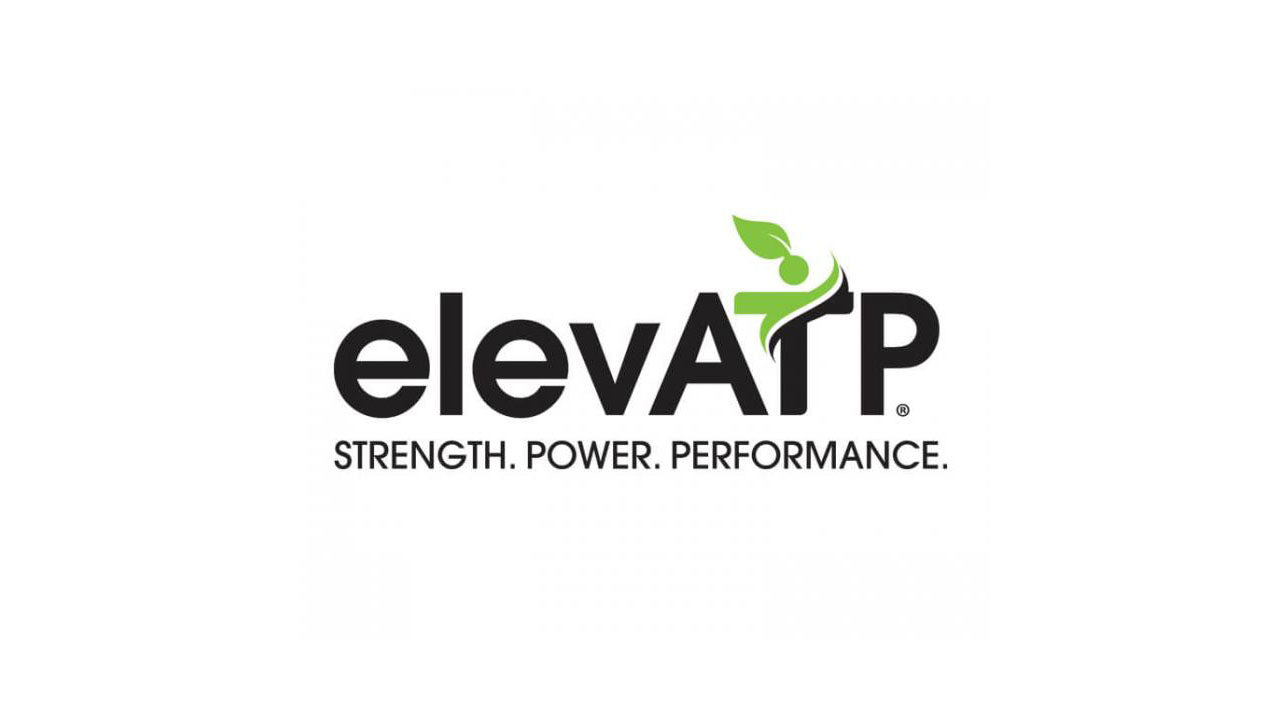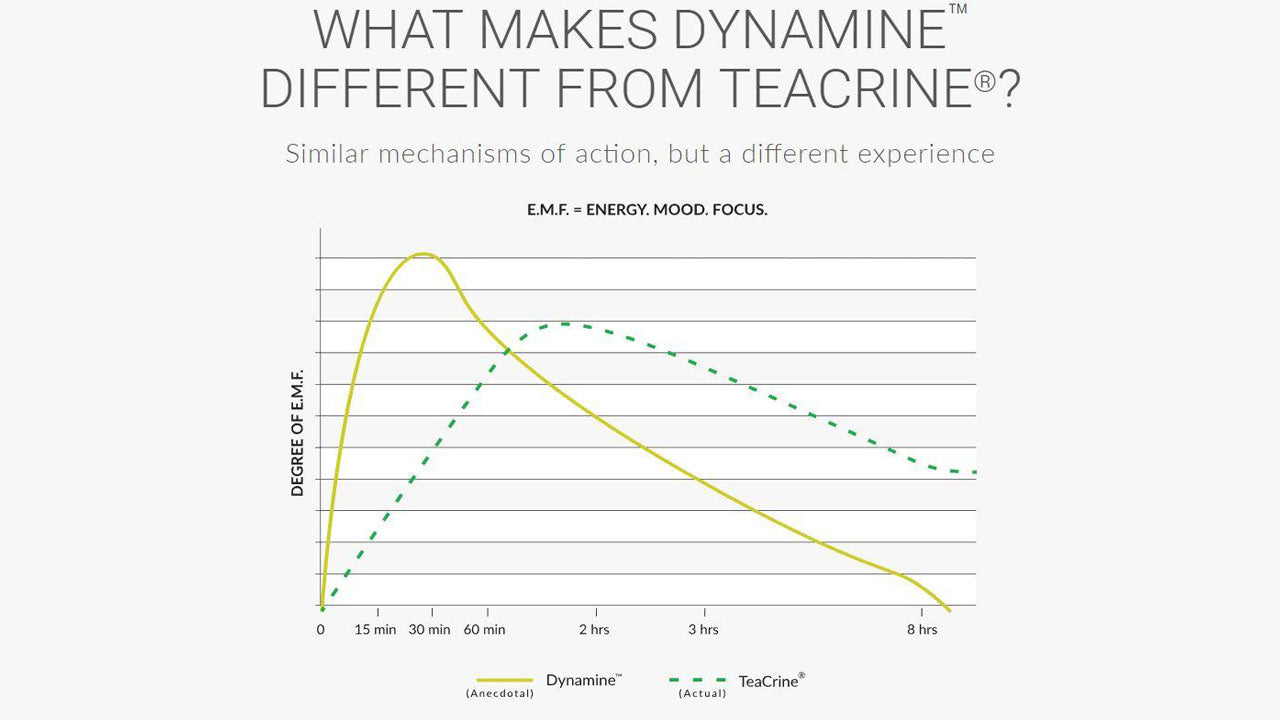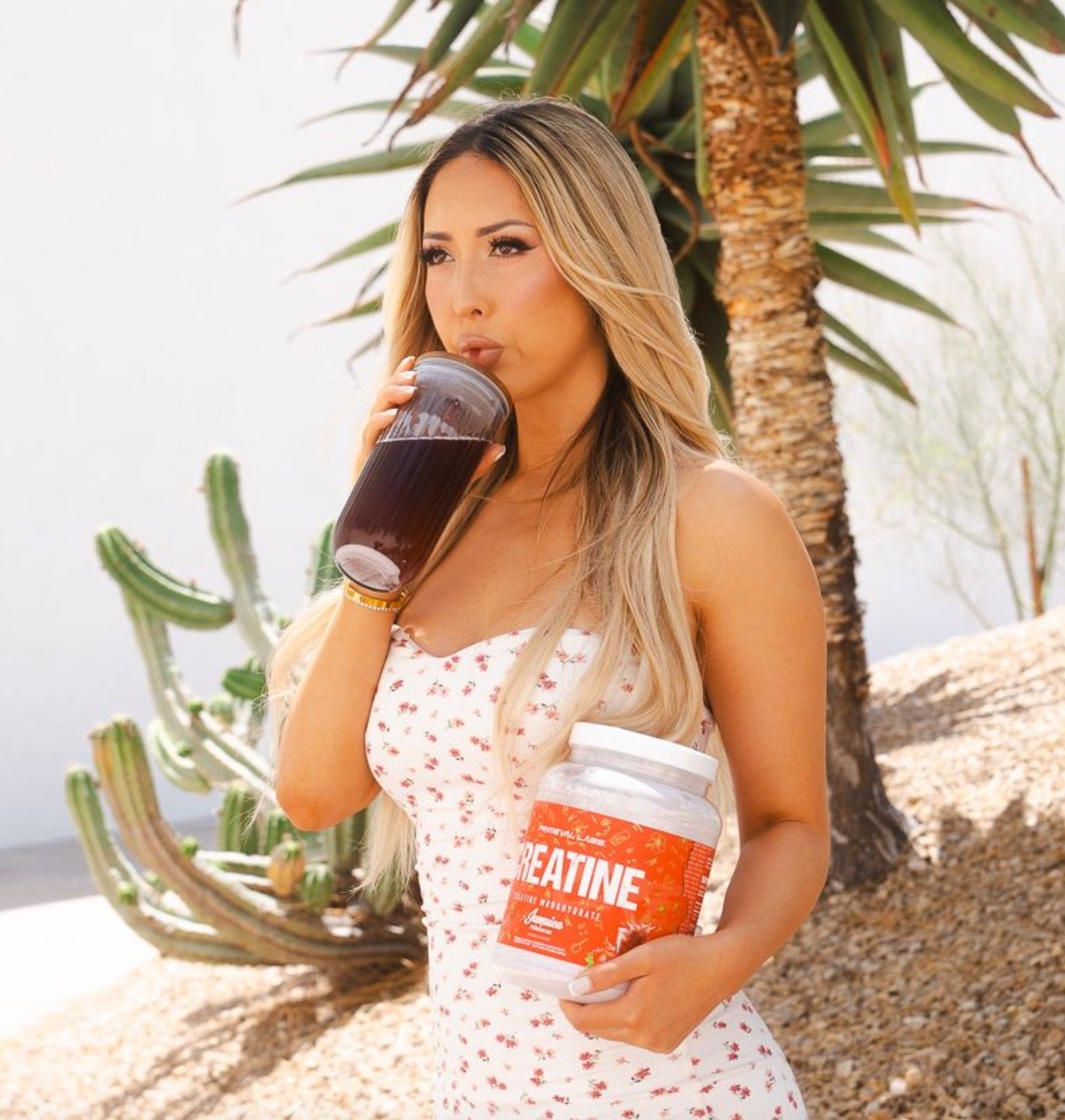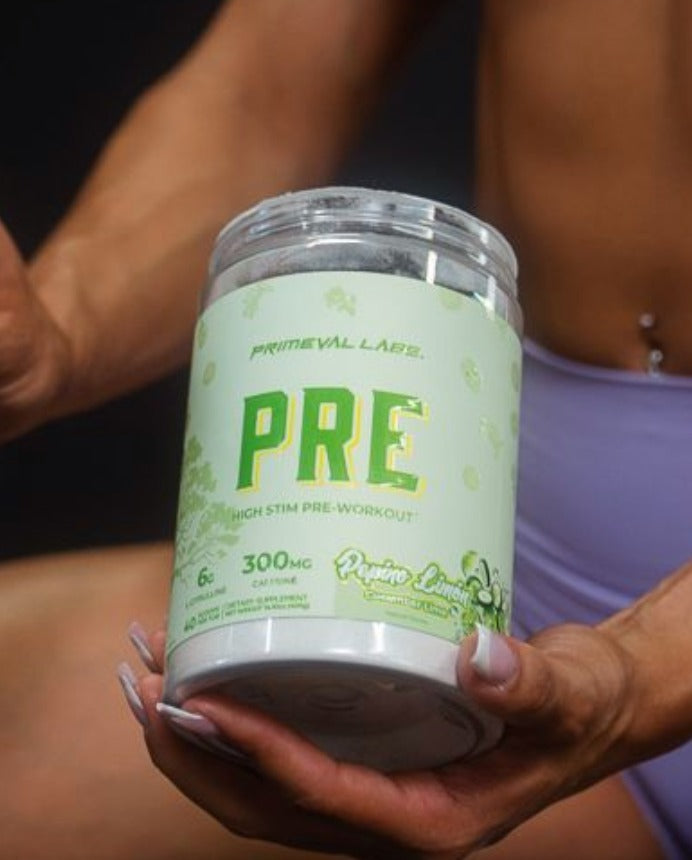ATP (adenosine triphosphate) is best known as the “cellular currency” of energy production.
The mitochondria in our cells generate ATP which is then used to do work (such as lifting weights).
The more ATP you have, the more efficiently you can create energy for your cells to do work. This is particularly important for individuals seeking to boost performance in the gym or on the field of competition and delay the onset of fatigue.
Furthermore, a number of studies have found that higher ATP levels are associated with improved health and performance.[7,8,9]
But, ATP’s role in the body extends beyond serving as a mere currency for exercising muscles.
It is also involved in hundreds of biochemical reactions and several extracellular functions, too.
To name a few, ATP is involved in:
- Neurotransmission,
- Platelet aggregation
- Clotting
- Immune response
- Cell recognition
As is the case with most things in life, natural ATP production declines as we age, which is a contributing factor to declining performance, reduced cognitive function, and low feelings of energy.
A number of ATP supplements have been developed over the years to increase ATP levels in the body, but most have come up short in testing.[1,2,3,4]
Today, we look at one of the more promising ATP-boosting supplements on the market in elevATP.
What is elevATP®?

elevATP® is a patented ingredient from FutureCeuticals formed from a natural combination of ancient peat and apple extracts.
The polyphenols contained in the extract have been noted in several human studies to increase levels of endogenous ATP in the body as well as improve strength, power, and performance in resistance-trained athletes.[5,6,7,8]
As we mentioned above, a number of other exogenous ATP supplements have been tested over the years with mixed results.[5,6,7,8]
The primary reason previous exogenous ATP supplements have failed is due to poor bioavailability. Even using doses as high as 5 grams of oral ATP have failed to provide benefit.[5,6]
This has led researchers to wonder if it’s possible to attack the problem of increasing ATP levels by other means.
One potential solution to increasing ATP levels in the body is elevATP.
How is elevATP® different from other ATP Supplements?
Unlike other oral ATP supplements that try to directly raise levels of ATP by providing an exogenous source of the compound, elevATP® helps our cells produce more ATP on their own.
What is in elevATP?
The initial studies carried out on ATP were to ascertain what the bioactive present in the supplement were as well as if it actually did what it claimed to do -- increase ATP.
Researchers found a total of 66 minerals present in the ancient peat and apple extracts:

The main plant phenolic component of elevATP was chlorogenic acid (5-O-caffeoylquinic acid), having a concentration of 201±11 mg / 100g.
The second most prevalent phenolics in the supplement were procyanidins -- oligomeric compounds formed from catechin and epicatechin molecules.

Procyanidins are abundantly found in fruits, vegetables, nuts, legumes, and grains and have been noted to possess a wide range of beneficial biological effects.[9,10,11]
Let’s now take a look at the studies to see what else elevATP® has to offer.
elevATP® Research
Pilot Study
The initial study involved 18 healthy individuals between the ages of 21 and 55 with a BMI between 21 and 30 kg/m2. Individuals participating in the study also could not be using any type of medication or supplements for a period of at least 15 days prior to the start of the study.
On the day of testing, subjects were instructed not to eat for 12 hours prior to the initial blood draw.
They were divided into two groups:
- Placebo: received 50 mg of encapsulated silica oxide
- Treatment: received 150 mg of encapsulated elevATP.
Both groups received 200 ml of water to swallow with their respective capsule.
Body temperature and blood samples were taken prior to and during the testing period.
Blood samples were immediately prior to capsule administration (T0) and at 60, 90 and 120 minutes following ingestion.
ATP levels obtained from samples collected at 60, 90, and 120 minutes were averaged and compared the effect of elevATP to placebo.
Compared to the placebo group, the participants receiving elevATP™ experienced an acute increase in blood levels of ATP by 64% (P=0.02).

Figure 1: Effect of elevATPTM on blood ATP levels. Whole blood was collected from placebo-treated or elevATPTM-treated subjects at T0 (baseline), T60, T90 and T120. ATP was detected by using a luciferase-based assay on 10μl of lysed whole blood.[5]
Researchers also noticed that levels of reactive oxygen species (ROS) were slightly lower in the elevATP group than those receiving placebo.[5]
The reason this is noteworthy is that previous research has found that increased ATP production is associated with greater concentrations of intracellular ROS, which can lead to oxidative stress and cellular dysfunction.[12,13]
Researchers attributed this to the polyphenolic compounds naturally present in elevATP, which could help reduce ROS, thereby decreasing their overall levels.
Study #2
The follow-up study to the pilot sought to extend the work using a crossover design and a larger group of subjects.
For this second study, researchers also collected a biopsy of muscle tissue from one individual before and after a single dose of elevATP™ in order to determine intramuscular ATP levels.[6]
20 “generally healthy” subjects (12 female and 8 male) ranging in age from 22-35 years old and BMI ranging from 24.1 to 30 kg/m² were selected to participate.
To be considered “generally healthy”, subjects had to be free of infections, influenza, and diabetes mellitus. They also had to have no allergies to dietary products, use of anti-inflammatory drugs, analgesics, statins, diabetic drugs, anti-allergy medicines, multivitamins, and use of supplements within 15 days of the start of the study.
Similar to the pilot trial, participants were instructed not to eat for 12 hours prior to the initial blood draw.
Since this was a crossover design, all subjects received both treatments (placebo and elevATP).
On day 1, subjects received the placebo treatment, and on their second day reporting to the lab, they received 150mg elevATP.
Blood samples were collected immediately prior to test capsule ingestions and at 60 and 120 minutes post-ingestion.
After tabulating the data, researchers noted that administration of elevATP increased ATP levels by 40% at the 1-hour mark.

Additionally, researchers found no changes in plasma ATP levels after treatment with elevATP™, indicating elevATP™ likely does not affect extracellular ATP levels.[6]
Study #3 & #4
While the first two studies showed that elevATP could enhance ATP levels, neither of them investigated the potential for the ingredient to improve exercise performance.
The 3rd and 4th studies on elevATP did.[7,15]
While these are two separate studies on paper, it’s really the same group of subjects being tested. The researchers collected a massive amount of data and wrote two separate papers based on their findings.
25 healthy resistance-trained men (age 27.7 ± 4.8 years) completed this study.[7,15]
To qualify as “resistance-trained”, each subject was required to be able to squat and deadlift 1.5× their body weight and bench press 1× body weight.
Note: Approval for research with human subjects was obtained from the MusclePharm Sports Science Institute IRB.
Subjects were randomly assigned to either the placebo or treatment groups and instructed to consume 1 serving of either placebo or elevATP® 45 minutes prior to training on training days or at a similar time of day on rest days.
Subjects were resistance-trained under the supervision of a certified strength and conditioning specialist 3 days per week for 8 weeks followed by a 2-week overreach and 2-week taper phase corresponding to weeks 9–10 and 11–12, respectively.
The first 8 weeks of training consisted of:
-
One “hypertrophy” workout comprising barbell back squat, bench press, deadlift, incline bench press, power squat, hammer strength iso lateral bench press, leg press, leg extension, leg curl, and triceps extension performed for 3 sets of 6–12 repetitions at 65%–80% 1-repetition maximum (1RM) intensity.
Rest periods varied between 30-120 seconds.
-
One “power” workout comprising barbell back squat, bench press, and deadlift performed for 5 sets of 2–5 repetitions at 40%–60% 1RM intensity with a goal of high velocity of movement.
Rest periods varied between 2-5 minutes between sets.
Note: After performing the main exercises on the power day, subjects performed bent over row, pulldown, dumbbell row, shoulder press, lateral raise, and bicep curl exercises for the goal of muscle hypertrophy as described for chest and leg exercises
-
One “strength” workout comprising barbell back squat, bench press, deadlift, shoulder press, and pulldown performed for 3 sets of 1–5 repetitions at 85%–100% 1RM intensity.
Rest periods varied between 2-5 minutes between sets.
Note: Following the resistance exercises, participants performed 2–6 sets of 10-30-second Wingates with 2–4 min of rest on a cycle ergometer.
Participants rested 48–72 hours between each training day.

During the “overreaching phase” (weeks 9-10), participants performed high-volume workouts, similar to the hypertrophy-focused workouts performed during weeks 1–8, on Monday through Thursday.
Friday of week 9 was focused on a strength workout, and Friday Week 10 was performance testing.
The final two weeks (“taper weeks”) consisted of:
- Monday -- power day
- Wednesday -- strength and power day
- Friday -- strength and power day
Exercises on these days included low volume back squats, bench press, and deadlifts only.
Additionally, subjects each consumed a eucaloric (“maintenance”) diet consisting of:
- 50% calories from carbohydrates,
- 25% from protein, and
- 25% from fat
Eucaloric diets were used to offset the possibility that extra food was responsible for the gains in performance and size, instead of the supplement.
Researchers tracked each subject’s diet weekly via 3-day food logs.
Subjects also consumed one serving of a whey protein supplement supplying 25g of protein, 5g of carbohydrate, and 1.5g of fat immediately following their workout on training days.
During the 12 week trial, researchers assessed progress across a wide range of performance and body composition metrics, including peak power, average power, and average speed.
Measurements were taken at the beginning of the trial, and then repeated at the 4, 8, 10, and 12 week marks.
Both groups experienced increases in strength and size.
However, the individuals receiving elevATP experienced greater gains in size, strength, and power than the placebo group.
More specifically, subjects receiving elevATP increased their 1-RM squat and deadlift scores to a greater degree than those receiving placebo.[15]

Additionally, vertical jump peak velocity and vertical jump peak power increased more in the treatment (TRT) group compared to the control (placebo) group.
Unfortunately for you bench press fans, elevATP® supplementation did not seem to statistically impact bench press 1RM respective to placebo.
However, elevATP supplementation helped attenuate power loss during the overreaching phase.[15]
This suggests that elevATP supplementation may help you experience less of a decline in power output during higher volume and intensity phases of your training.
Researchers concluded, saying:
“This is the first study examining the ergogenic potential of endogenous ATP enhancement with supplementation. The proprietary blend of ancient peat and apple extracts were capable of increasing lower body and total strength as well as lower body power output compared at an equal-volume, visually-identical placebo.”[15]
Researchers used DEXA to assess body composition metrics, including:
- Lean soft tissue (LST)
- Fat mass (FM)
- Body fat percentage (BF%)
Ultrasound was also used to measure muscle cross-sectional area (CSA), muscle thickness (MT), and fat thickness (FT).
After 12 weeks of supplementation with elevATP, both muscle cross-sectional area and muscle thickness increased while body fat content and body weight were unchanged.
In the placebo group, muscle cross-sectional area tended to decline following the overreaching and taper phases.
Researchers hypothesized that the elevATP supplement helped lessen (“attenuate”) performance decrements (i.e. “overtraining”) that can potentially go along with increased training volume and overreaching (or sometimes just not eating or sleeping enough to support the demands of training.)
Note: It should be mentioned that two authors involved in the study were at the time employees of VDF FutureCeuticals Inc. Additionally, several other authors on the paper (JJ, RV, PF, MM, MK, and JM) were employed by the grant recipient, MusclePharm Corp., at the time of data collection.
This doesn’t necessarily “negate” or nullify the quality or findings of the study, but just something to be aware of.
Study #5
The next study on elevATP again measured its effects on athletic performance in resistance-trained men over the course of a 12-week training program.
However, instead of just testing elevATP on its own against placebo, researchers paired it with an extended-release caffeine supplement.[17]
This study was carried out by the same lab as the previous two studies (Jordan M. Joy and colleagues).
To be considered well trained, each male had to be able to lift 1.5x BW in the squat and deadlift and 1x bodyweight in the bench press.
Baseline assessments noted that the placebo group was able to:
- Squat 1.71 ± 0.21 times BW
- Deadlift 2.17 ± 0.25 times their bodyweight, and
- Bench press 1.45 ± 0.19 times their BW
Baseline metrics for the treatment group were:
- Squat 1.58 ± 0.2 times BW
- Deadlift 1.97 ± 0.26 times BW
- Bench press 1.33 ± 0.20 times BW
Overall, it would appear that the placebo group started out being slightly stronger (on average) than the treatment group.
The resistance training program was very similar to that used in the previous two studies (8 weeks of training 3x per week with one training session each week devoted to hypertrophy, strength, and power training, 2 weeks of overreaching, and 2 weeks of tapering).
Body composition measurements of the subjects were gathered at weeks 0, 4, 8, 10, and 12, while blood draws and vital signs were collected at weeks 0, 8, and 12.
Similar to the previous two studies, researchers used a combination of DEXA and ultrasound to track changes in lean soft tissue, fat mass, body fat percentage, muscle thickness, and cross-sectional area.
21 subjects randomized to either the placebo (n = 11) or treatment (n = 10) groups.
The treatment for this study included the same 150mg dose of ElevATP used in previous studies, but added to it 38mg of B-vitamins along with a 180mg blend of caffeine anhydrous and PurEnergy™
PurEnergy™ is extended-release caffeine composed of 43 % caffeine and 57% pterostilbene.
The total caffeine “payload” for the entire supplement was ~129 mg.
At the end of the study, ultrasound-based measurements of muscle thickness and cross-sectional area increased while fat mass and body fat percentage decreased in the lower body.

Researchers believe that the increases in muscle mass documented were likely produced by supplementation with elevATP. They also speculate that the modest reduction of body fat observed in the treatment group, versus a slight increase in body fat in the placebo group, is likely due to the caffeine component of the supplement.
The reason for this is that caffeine is known to promote lipolysis and enhance fat oxidation during exercise.
Though, they do not discount the possibility of a synergistic effect existing between caffeine and the polyphenols in elevATP.
Unfortunately, this study did not measure whole-blood or intramuscular ATP levels, but based on previous work, we do have evidence indicating that supplementation with 150mg elevATP does boost ATP levels.
And, it’s also hard to determine how much of the effect is really attributable due to the elevATP component of the supplement since the researchers did not have a “caffeine only” group run through the same training program.
Researchers justify this by noting that while caffeine has been noted to improve exercise performance, it largely does so by increasing the number of repetitions performed to failure while reducing perceptions of fatigue.[18]
In this study, however, there were no significant changes in training volume performed between groups over time according to the authors.
Still, the dose of caffeine used in this study is on the low end for performance enhancement (~129mg total) as the current body of evidence suggests that a dose of 3-6mg/kg caffeine is required to derive its ergogenic benefits.[19]
Study #6
The final study to date on elevATP was led by the team of researchers who published the first two papers on the supplement -- Reyes-Izquierdo and colleagues.
In this study, researchers performed a blinded three-way crossover study in nine “healthy” subjects (4 female and 5 male) comparing the effects of placebo vs a single 150mg dose of elevATP before, during, and after 20 minutes of stepping exercise.[16]
Subjects in this study were not regular exercisers with an average age of 27.3 ± 5.0 years and BMI of 28.97 ± 6.6 kg/m2. The BMI of the group technically places them in the “overweight/mildly obese” category,
Subjects fasted for 12 hours prior to each of the three exercise study days.
Additionally, subjects took a 10-day “recovery” period between each exercise day.
On day 1, subjects were randomly given capsules containing:
- 150mg elevATP (Lot A)
- 150mg elevATP (Lot B)
- Placebo
Subjects were also given two Smucker’s Uncrustables® sandwiches to eat 15 minutes after taking a capsule.
Researchers gave subjects this meal to prevent hypoglycemia during exercise.
Each sandwich contained:
- 210 calories
- 28g carbohydrates
- 9g fat
- 6g protein
Researchers collected blood samples (via finger prick) before ingestion of capsule (T0) and, 35 min after the consumption of snacks (T50).
Afterward, subjects were instructed to exercise.
Additionally, blood samples were collected after completion of the 20-minute stepping exercise (T70) and after 30 minutes of rest following exercise (T100).
Total steps and calories burned were recorded by the stepper.
At the end of the study, researchers noted that when subjects received the elevATP supplement, they burned more calories and took more steps than subjects receiving a placebo.
- Lot A: 148 ± 18.8 calories vs placebo: 130 ± 20 calories, P=0.008
- Lot B: 154 ± 27 calories vs. placebo: 130 ± 20 calories, p = P.004

Analysis of the blood samples revealed there were significant differences in blood lactate or glucose levels between elevATP treatments and placebo.
Takeaway
elevATP is a combination of ancient peat and apple extracts that, when used in combination with a structured resistance-training program, may:
- Support gains in lean muscle and strength*
- Enhance power output and training volume*
- Helps reduce performance decrements associated with overreaching*
- Helps improve athletic performance and body composition*
- Supports higher levels of mitochondrial ATP*
Where Can I Find elevATP?
If you're curious to try elevATP, you won't have to look far as Primeval Labs includes it in several of their top-rated pre workout supplements, including:
References
- Arts, I.C., Coolen, E.J., Bours, M.J. et al. Adenosine 5′-triphosphate (ATP) supplements are not orally bioavailable: a randomized, placebo-controlled cross-over trial in healthy humans. J Int Soc Sports Nutr 9, 16 (2012). https://doi.org/10.1186/1550-2783-9-16
-
Coolen EJ, Arts IC, Bekers O, Vervaet C, Bast A, Dagnelie PC. Oral bioavailability
of ATP after prolonged administration. Br J Nutr. 2011;105:357–66 - Herda TJ, Ryan ED, Stout JR, Cramer JT. Effects of a supplement designed to increase ATP levels on muscle strength, power output, and endurance. J Int Soc Sports Nutr. 2008;5:3.
- Jordan AN, Jurca R, Abraham EH, Salikhova A, Mann JK, Morss GM, Church TS, Lucia A, Earnest CP. Effects of oral ATP supplementation on anaerobic power and muscular strength. Med Sci Sports Exerc. 2004;36:983–90Reyes-Izquierdo T, Nemzer
- B, Argumedo R, Shu C, Huynh L, Pietrzkowski Z. Effect of the dietary supplement ElevATP on blood ATP level: An acute pilot clinical study. J Aging Res Clin Practice. 2013;2:178–84.
- Reyes-Izquierdo T, Shu C, Argumedo R, Nemzer B, Pietrzkowski Z. The effect of elevATPTM on whole blood ATP levels: a single dose, crossover clinical study. J Aging Res Clin Practice. 2014;3:56–60.
- Joy, J. M., Falcone, P. H., Vogel, R. M., Mosman, M. M., Kim, M. P., & Moon, J. R. (2015). Supplementation with a proprietary blend of ancient peat and apple extract may improve body composition without affecting hematology in resistance-trained men. Applied Physiology, Nutrition, and Metabolism, 40(11), 1171–1177. https://doi.org/10.1139/apnm-2015-0241
- Joy, J. M., Vogel, R. M., Moon, J. R., Falcone, P. H., Mosman, M. M., & Kim, M. P. (2016). Twelve weeks supplementation with an extended-release caffeine and ATP-enhancing supplement may improve body composition without affecting hematology in resistance-trained men. Journal of the International Society of Sports Nutrition, 13(1). doi:10.1186/s12970-016-0136-9
- Swamy MS, Sivanna N, Tamatam A, Khanum F. Effect of polyphenols in enhancing the swimming capacity of rats. Funct Foods Health Dis. 2011;1:482–91
- Rue EA, Rush MD, van Breemen RB. Procyanidins: a comprehensive review encompassing structure elucidation via mass spectrometry. Phytochem Rev. 2018;17(1):1–16. doi:10.1007/s11101-017-9507-3
- Masumoto, S., Terao, A., Yamamoto, Y. et al. Non-absorbable apple procyanidins prevent obesity associated with gut microbial and metabolomic changes. Sci Rep 6, 31208 (2016). https://doi.org/10.1038/srep31208
- Rauf, A., Imran, M., Abu-Izneid, T., Ihtisham-Ul-Haq, Patel, S., Pan, X., Rasul Suleria, H. A. (2019). Proanthocyanidins: A comprehensive review. Biomedicine & Pharmacotherapy, 116, 108999. https://doi.org/https://doi.org/10.1016/j.biopha.2019.108999
- Chang, J.C., et al., Regulatory role of mitochondria in oxidative stress and atherosclerosis. World J Cardiol, 2010. 2(6): p. 150-9
- Swamy, M.S.S., Naveen; Tamatam, Anand and Khanum, Farhath Effect of Poly Phenols in enhancing the swimming capacity of rats. Functional Foods in Health and Disease, 2011. 1(11): p. 482-491
- Joy JM, Vogel RM, Moon JR, et al. Ancient peat and apple extracts supplementation may improve strength and power adaptations in resistance trained men. BMC Complement Altern Med. 2016;16:224. Published 2016 Jul 18. doi:10.1186/s12906-016-1222-x
- Reyes-Izquierdo T, Nemzer B, Argumedo R, et al. The Effect of ElevatpTM on Exercise Output: A Single Dose, Blinded, Three-Way Cross-Over Study. 2016, 1:2.
- Joy, J. M., Vogel, R. M., Moon, J. R., Falcone, P. H., Mosman, M. M., & Kim, M. P. (2016). Twelve weeks supplementation with an extended-release caffeine and ATP-enhancing supplement may improve body composition without affecting hematology in resistance-trained men. Journal of the International Society of Sports Nutrition, 13(1). doi:10.1186/s12970-016-0136-9
-
Duncan MJ, Oxford SW. The effect of caffeine ingestion on mood state and
bench press performance to failure. J Strength Cond Res. 2011;25:178–85 - Goldstein, E.R., Ziegenfuss, T., Kalman, D. et al. International society of sports nutrition position stand: caffeine and performance. J Int Soc Sports Nutr 7, 5 (2010). https://doi.org/10.1186/1550-2783-7-5













Leave a comment
This site is protected by hCaptcha and the hCaptcha Privacy Policy and Terms of Service apply.